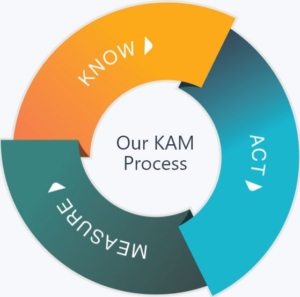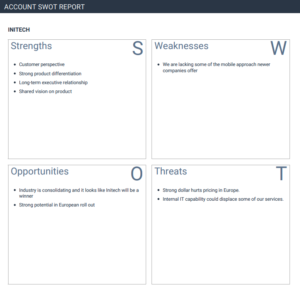Our KAM Process: Deep Dive into KNOW
in SWOT, Customer Engagement /Last week, we wrote a high-level summary of Our KAM ProcessTM, a proven methodology for building customer engagement and transforming customer relationships:
- Know more, so you can plan better
- Act strategically and effectively to drive meaningful change
- Measure that change across multiple endpoints

The process is cyclical because engaged, satisfied, successful clients are going to want to keep working with you. Every time you start a new quarter, a new year, a new contract, scope, or initiative with a customer, you return to the beginning, asking what you know now, and how you can use what you’ve learned to act and measure even more effectively this time.
Now that we’ve outlined the process as a whole, we’re going to spend the next three weeks diving into each section in more detail. The spotlight this week is on getting to know your clients better than ever before, with practical emphasis on how and why we do it the way we do.
Understand the Overall Structure
We always start here, with the org chart. For one thing, it’s a straightforward first step: Just import your accounts and contacts from your existing CRM or other platforms. For another thing, it’s extremely helpful to visualize the overall reporting structure at your customer’s organization, even if you do the bulk of your work with a few key contacts. Here’s why:
Understanding reporting structure gives you a better sense of what your day-to-day contact is juggling in their job. In addition to meeting project goals, whom do they need to engage, convince, or impress to be successful in their organization? When you have the big picture in mind, you can be proactive about making sure you get buy-in from the right people at the right point in a project. You can build in time for stakeholder review and revisions as you create timelines, so they don’t blindside you late in the game. And you can help support your clients in a way that makes them not only successful in their endeavors, but also successful in the broader landscape of their job.
A good sense of overall structure and culture also helps strengthen the relationship between your organization as a whole and your client’s organization as a whole. This creates sustainable, long-term relationships at the organizational level that last, even when someone changes jobs or shifts roles. And it creates more opportunities for cross- and upselling, since your contact will be more willing to work with other people at your organization who offer unique perspective and services.
Get Personal
Now that you’ve established the overall structure, it’s time to dive deeper into the goals, motivations, and expectations of key individual clients. Kapta helps you do this with a template for building detailed client profiles. A key component of these are the Voice of Customer (VOC) tools, a series of questions designed to probe deeper into what your client is trying to accomplish, and how they expect you to help.
Start by customizing your questions. Because we’ve been doing Key Account Management for a long time, we’re able to provide a starting point for VOC questions. These are based on our experience and general best practices. However, they are just a starting point. As time goes on, it’s important to customize or expand on the original list of questions to continue the conversation you’re having with that client, and capture their specific needs.
Think about this on a personal level. You might start a new friendship asking the usual questions: “Where are you from? What do you do? Do you have siblings?” But as time goes on, your conversations get more unique, and your questions more relevant to that friend’s life. The same applies for customers. Make sure you’re using VOC tools to ask specific, relevant questions that relate to their industry, their company, their goals, and more.
In addition to customizing VOC tools, consider face or phone time to talk through questions with your client, rather than relying too heavily on emailed surveys. A well-placed email or text is sometimes the time-saver everyone needs, but it’s not the right way to tackle big questions.
Get Strategic
Now that you know what your client is trying to accomplish, it’s time to take a look at the internal and external factors that might support—or inhibit—their success. The best way to do this is the tried-and-true SWOT analysis.
A SWOT analysis consists of 4 components: Strengths, Weaknesses, Opportunities, and Threats. Strengths and weaknesses are internal; opportunities and threats are external. A SWOT analysis is often presented in a grid like this one.

We find the best way to conduct a meaningful SWOT analysis is to conduct an in-person, interactive workshop with your client. Start by doing your research. You want to show up to the meeting already prepared with at least a few thought-starters in each category. This gets the conversation going so you can capture even more insights from people in the room. (Remember, as a rule, it’s always easier for your clients to react to something that already exists than to generate ideas out of thin air. Preparation helps prevent putting clients on the spot in an awkward way.)
In addition to thinking through the SWOT itself, think through who should be in the workshop. This can be a great chance to hear perspectives from across your customer’s organization, in order to build a truly comprehensive analysis. It’s also a chance to gain alignment among key players as you start to identify key priorities for action planning.
Once you’ve conducted your SWOT analysis workshop, capture the information in Kapta to keep it front and center for yourself and your team as you move forward with the next phase of Our KAM Process: Action planning.
Benefits of Customer Knowledge
In many ways, the benefits of customer knowledge should go without saying. But some are less obvious than others, and it’s useful to remember what customer knowledge can help you do—especially since, like any aspect of Key Account Management, it requires time, effort, and in-person meetings. With strong customer knowledge:
- You can be more proactive. When you know more about what your customer is trying to accomplish, you can be on the lookout for opportunities to make those things happen for them. For example, if you know they need approval from their boss to move forward with something, you can schedule an approval milestone into your timeline, and offer to facilitate the process. This not only makes your contact’s life easier, but also puts your company in front of their boss.
- You can upsell more effectively. When you understand your customer’s needs, upselling and cross-selling don’t even really feel like “selling.” Instead, they feel like offering welcome solutions to a challenge you know your client is facing. Bundling products and services improves your bottom line and makes it more attractive for your customer to work with you on multiple initiatives, thus strengthening the relationship between your organization and theirs.
- You make yourself harder to replace. The more you know about your customer, their company, their industry, and their challenges, the harder it would be to get a different vendor up to speed in the same way. Not that you want your customers to stick with you out of inertia alone, but it’s important to remember your knowledge is a competitive asset.
- You make it easier to move past mistakes. Everyone has bad days. In the course of a long-term relationship with a client, you will inevitably make mistakes, miss a deadline, or miscommunicate. If you have a strong personal relationship with your clients, they will often be willing to work through those errors. And when they have a bad day—miss a meeting, lose their temper, etc—you’ll be more likely to understand what’s stressing them out, and better able to move on quickly.
- You boost your satisfaction at work. The people you work with significantly influence your quality of life. When you spend all day, every day talking to your customers, it can add meaning and satisfaction to your job and your life to get to know them as people.
Conclusion
We believe very strongly that putting customers first can improve your company’s bottom line. And that starts with really knowing your customer: Who they are, what they want, how they work, what they’re good at, what frustrates them, and, above all, how you and your team can help them succeed.
For a deep dive into Kapta’s tools for generating and capturing customer knowledge, schedule a demo.







